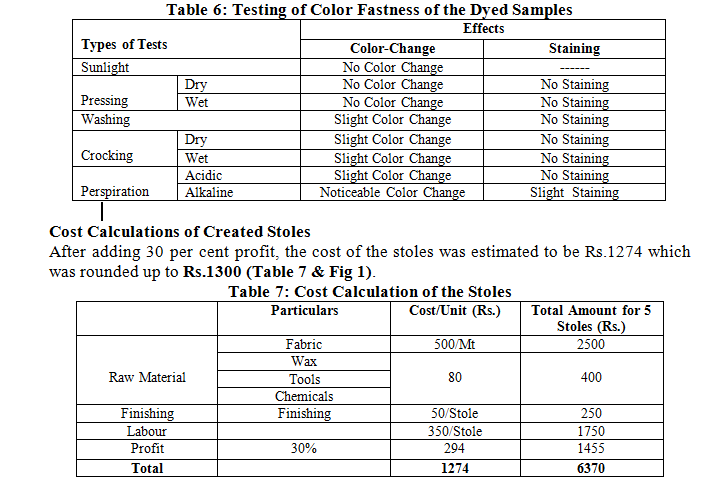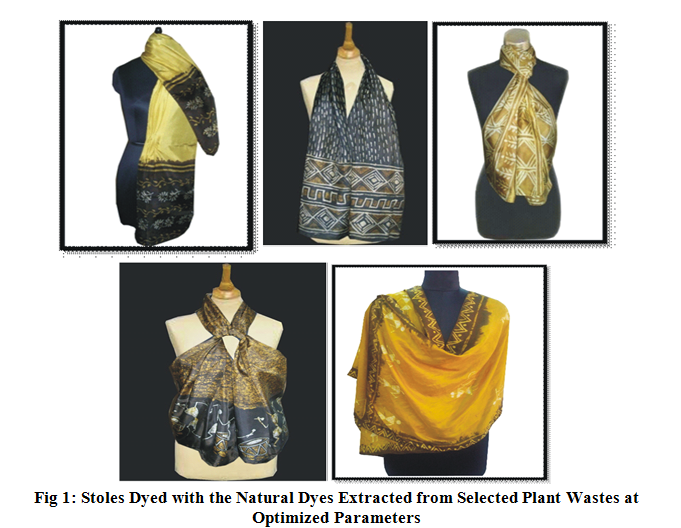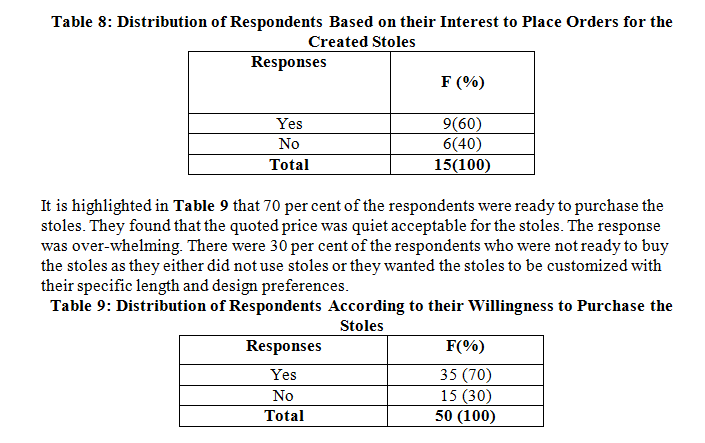Alleviation: An International Journal of Nutrition, Gender & Social Development, ISSN 2348-9340
Volume 2, Number 2 (2015) : 1-7
©Arya PG College, Panipat & Business Press India Publication, Delhi
www.aryapgcollege.com, www.apcjournals.com
Revival of Batik with Natural Dyes from Selected Plant Wastes
1. Megha Bakshi & 2. Chhaya Verma
1. Assistant Professor, UIFT, Panjab University, Chandigarh, India
2. Assistant Professor, Government Home Science College, Chandigarh, India
E-mails: 1. mysteriousme05@gmail.com
2. chhaya_chandu@yahoo.com
Introduction
Rivers turn into bright green one day and yellow the next. Fishes are washed ashore and vegetation is left strangled as if crying for life, humans consume poisonous chemicals that nobody knows came from where and the strange and sudden illness that seemed as if only Gods could have sent.
This isn’t a scenario out of nowhere, nor an empty prediction of some prophet of doom. This is what is happening all around and thus a true story. Most garments are produced in developing countries where pollution controls are often nonexistent. Discharges go straight into rivers from huge numbers of the textile producers. Developing countries are also lacking in standards and enforcement concerning the use of toxic chemicals in dyes and garment finishes. Thus the need of hour is environment friendly products, therefore providing a wide room for Natural dyes (Aggarwal 1996).
An urgent need was felt to restore the art of dyeing fabric with natural extracts. So optimization was needed to be done in order to develop methods to dye the fabric at low temperatures to get darker shades.
The need of the study originated due to the fact that the napthol dyes, are easily available as Batik colors in the market and are continued to be used inspite of its proven harmful effects on degradation of our environment. Thus, an effort has been made to utilize natural dyes for batik. Moreover the use of vegetable materials in textile coloration is a well-known way of utilizing renewable raw materials according to the technical, economic and ecological requirements of 21st century. Unlike non-renewable basic raw materials for synthetic dyes, the natural dyes are usually renewable, being agro-renewable/vegetable based and at the same time biodegradable. Moreover, application of natural dyes has a potential to earn carbon credit by reducing consumption of fossil fuels (Petroleum) in comparison to synthetic dyes, thus making it energy efficient (Samantha & Konar 2011).An urgent need was felt to restore the dying art of Batik. Optimization was needed to be done in order to develop methods to dye the fabric at low temperatures with natural dyes to get darker shades in batik. Application of natural dyes has potential to earn carbon credit by reducing consumption of fossil fuels in comparison to synthetic dyes, thus making it energy efficient. The present study was undertaken with the following objectives in mind: To explore various plant wastes in order to select suitable raw material for extraction of dye.
1) To optimize parameters for mordanting and dyeing.
2) To evaluate the color fastness of the dyed samples.
3) To prepare stoles of Batik design using selected combinations of dyes and mordants.
4) To determine the marketability and consumer acceptance of created stoles.
Methodology
Selection of Suitable Raw Material for Extraction of Natural Dyes
Different plant wastes were collected from various sources like onion peel, katha, madder, kapok flower, pomegranate rind and myrobalan. Myrobalan was picked from Rose garden that went unnoticed and were rotting there, used marigold flowers were collected from temples and marriage halls. Onion peels and pomegranate rind were collected as kitchen waste and fallen kapok flowers were collected from college campus. All these collected materials were dried, grinded, soaked overnight in water and boiled for 1 hour for the extraction of natural dyes.
Selection of Fabric
Silk and cotton fabric samples were dyed with the extracted natural dyes with different parameters and then the dyed samples were evaluated visually for depth of color, brightness and evenness.

Preparation of Fabric
The fabric was soaked in mild detergent overnight. It was then cleaned by kneading and squeezing to remove impurities, rinsed thoroughly with water and dried in shade.
Selection of Suitable Mordants and Mordanting Techniques
Aluminum Potassium Sulphate (AlK(SO4)2.12H2O and Ferrous Sulphate (FeSO4), being the most eco-friendly of all metallic salts were selected. The samples were mordanted using pre, post and simultaneous mordanting techniques and then these were dyed. The dyed samples were evaluated visually for the best result.
Optimization of Parameters for Mordanting
To optimize mordanting temperature, mordanting was carried out at different temperatures, keeping the mordanting time and mordanting concentration constant (Table 1). To optimize mordanting time, mordanting was carried out for different time intervals keeping the rest of the parameters constant. The dyed samples were evaluated visually for the best result.

Optimization of Parameters for Dyeing
A test was conducted to determine the melting temperature of the wax (Paraffin and bee’s wax) that was to be used for batik (Table 2). The temperature for dyeing was selected keeping in mind the melting temperature of the wax to be used for resisting.
Selection of Color Combinations by Using Different Mordants and Mordanting Techniques with the Same Dye Various samples were dyed with different color combinations using two mordants with same or different concentrations and different mordanting techniques i.e. pre-mordanting and post-mordanting, on the same sample. Variations in colors could be obtained due to multi-tonal effect of natural dyes by changing the mordants and mordanting parameters. It was also observed that by varying the time between the extractions of dye and its application, different hue was obtained from the onion-peel dye. After evaluation, samples with the best contrast and visual effect were selected for the final products.
Evaluation of Color Fastness
Color fastness of the dyed samples was determined as per the specification given by American Association of Textile Chemists and Colorists (AATCC). After testing, the samples were evaluated for color change and staining with the help of Grey scale. Evaluation was carried out for color fastness to sunlight, washing, rubbing, pressing and artificial perspiration.
Creation of Stoles
The fabric was pre-mordanted with Aluminum Potassium Sulphate with optimized parameters. The design was traced on the fabric with the help of chalk powder. The wax was prepared by melting paraffin wax and bee’s wax in the ratio of 1:2 in a pan. Then the wax was applied with the help of a brush according to the design and was allowed to dry. This was done to retain the original color of the fabric i.e. white. Then the fabric was dyed with the extracted dye for 60 minutes at 45˚C. Concentration was kept constant i.e. 10 per cent (Overweight of fabric), the excess dye was rinsed off under running water and the fabric was dried in shade. The wax was applied again in order to resist the second color and finally the fabrics were post-mordanted with ferrous sulphate (Concentration 10%) at 45˚C for 30 minutes to produce the third color as per the requirement of the designs. The wax was removed by placing the fabric between layers of blotting paper and applying heat to it with the help of hot iron. The excess wax was absorbed in the papers and the remaining wax was removed by dipping the fabric in hot water along with mild detergent. The process was repeated and the fabric was rinsed thoroughly till all the wax was removed completely from the fabric.
Cost Calculation of the Stoles Created
The cost of each stole was estimated by adding the cost of fabric, dye, mordant, wax, tools, finishing and labour charges and 30 per cent profit was also added to the cost.
Marketability and Consumer Acceptance
Market acceptability of the stoles was checked by surveying leading shops. A questionnaire was prepared which consists of questions like whether the designs were liked by them, whether they would like to place order or not and whether the quoted price was reasonable to them or not. Responses were noted down from the owner of the shops and the data were then analyzed. To find out the consumer acceptability of the created stoles, a questionnaire was framed which consists of questions like whether the consumers were ready to buy those stoles on the quoted price and how they find the overall appearance of the stoles. Responses were noted down from the consumer. The data were then analyzed. Suggestions for further improvement in the design were also asked from the consumers.
Results and Discussion
The findings of the study are discussed under the following headings:
Selection of Fabric
Extracted natural dyes were applied on cotton and silk fabrics, deeper shades were produced on silk. Moreover dyestuffs were absorbed by silk more readily and at lower temperature than by any other natural fibers which was one of the important requirements in this study (Houston 1975). Thus pure silk fabric was finally selected for the study.
Selection of Raw Material for Dye Extraction
Darker and brighter shades were obtained from the dye extracted from onion-peel and marigold flower heads in comparison to dye extracted from other sources, thus they were selected as the raw material for dye extraction collected as kitchen waste and used flowers collected from temples and marriage halls (Table 3).

Selection of Mordants and Mordanting Techniques
The study aimed at preparing eco-friendly products, thus only alum and ferrous sulphate has been used as they are considered to be least toxic. Pre-mordanting and post mordanting techniques were used as the shades of dye obtained were comparatively darker and brighter compared to the simultaneous mordanting. Moreover for batik, the dyeing can’t be carried out at very high temperature i.e. above 50˚C as the wax used for resisting will melt.

Thus pre-mordanting technique was considered to be most suitable option. Although post-mordanting technique was also used in order to obtain different shade with the same dye with different mordants and mordanting techniques.
Optimized Parameters for Mordanting and Dyeing
Parameters for pre and post-mordanting and dyeing were optimized on the basis of visual evaluation of the dyed samples (Table 4).
Selection of Color Combinations
Various combinations were selected by keeping following points in view:
• Single dye with single mordant
• Single dye with double mordants (Table 5)

Color Fastness of the Dyed Samples
It can be seen from the Table 6 that almost all the dyed samples had very good to excellent color fastness with regard to color change as well as staining. Dyed samples showed excellent color fastness to sunlight and pressing as there was no change in color. Slight change in color was noticed when the dyed samples were exposed to washing, crocking and acidic perspiration but there was no staining on adjacent fabric. All the dyed samples showed noticeable color change and slight staining with alkaline perspiration though the change in color resulted in darker shade.


Market Acceptability of the Stoles Created
A market survey was conducted to see the market acceptability of the created stoles. The price quoted by the investigator was Rs.1300. It is highlighted in the Table 8 that 60 per cent of shop owners were interested in placing the order for stoles as they found the designs very interesting and the rate was reasonable whereas 40 per cent of them did not want to place the order as they wanted only to sell their own products or specific brand products.

Conclusions
From the above study, it was found that onion peel and marigold flowers extracts could be used for batik to dye the silk. Natural dyes could produce a wide range of colors by just varying the mordants and their concentration. Even the total energy consumption could be reduced as dyeing was carried out at low temperature, thereby reducing the carbon footprint of the environment, thus making it even more environment friendly. The dyed samples showed very good to excellent color fastness to different parameters, though the color of the fabric can be preserved by shade drying and dry cleaning. This could even be balanced by the charm and uniqueness of the natural dyes as it was difficult to reproduce them, thus making it more interesting and adding to its surprise factor. A very positive response was obtained by the customers as they were ready to buy the stoles and even placed orders for the same, thus making the product marketable and increasing its consumer acceptability.
References
Aggarwal P (1996) Extraction of Natural Dyes from Selected Plant Sources and Its Application on Wool and Silk. M.Sc Dissertation, Panjab University, Chandigarh.
Gohl EPG and Vilensky LD (2005) Textile Science. London: CBS Publishers and Distributers: 147-148.
Houston J (1975) Batik with Noel Dryenforth. London: Orbis Publishing Limited: 9-19.
Samantha AK and Konar A (2011) Dyeing of Textiles with Natural Dyes. Calcutta: Institute of Jute Technology.

